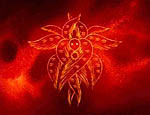FGC:OP Cut 001b: Difference between revisions
The wayneiac (talk | contribs) (Need to replace "edit" with cut noumber on the ones that have already been edited) |
The wayneiac (talk | contribs) (This is what should have gone here) |
||
| Line 4: | Line 4: | ||
</noinclude>{{FGC:Cut|episode=OP | </noinclude>{{FGC:Cut|episode=OP | ||
|cutname=001b | |cutname=001b | ||
|images=[[Image: | |images=[[Image:OP C001b a.jpg]] | ||
|cutnumbertext=[[FGC:OP Cut 001b|001b]] | |cutnumbertext=[[FGC:OP Cut 001b|001b]] | ||
| Line 13: | Line 13: | ||
{{FGC:Script Text|type=description | {{FGC:Script Text|type=description | ||
|text= | |text=Image of an angel. | ||
}} | |||
{{FGC:Script Text|type=SE | {{FGC:Script Text|type=SE | ||
| Line 33: | Line 33: | ||
|comments= | |comments= | ||
{{FGC:Comment|name= | {{FGC:Comment|name=Reichu | ||
|comment= | |comment=The mysterious figure that appears is definitely worth taking note of. Eva tomo no kai has this to say about it: | ||
<font color=darkred> | |||
''The graphical figure that appears in the red universe is like a cherub. In traditional Catholic belief, cherubim are the second-to-highest ranking choir of angel. In Biblical tradition, when the cherubim are spread throughout the Garden of Eden, it becomes their duty to prevent Adam and Eve from approaching the Tree of Life.''</font color> | |||
As far as I can tell, the actual visual resemblance between cherubim and this figure is tenuous, at best. Multiple accounts describe them as being “many-eyed”, which works with the wings here. In the Book of Ezekiel (10:14), they are also described as having four faces, the fourth being that of eagle. While this figure appears only to have one, it could be construed as being vaguely eagle-like. I'm personally of the opinion that it's more like an owl's, being disc-shaped with forward-facing eyes. | |||
The twelve wings alternatively identify this as the infamous fallen angel Sammael (or Samael) — also known as Satan (and often, incorrectly, as “Lucifer”, due to a misreading of Isaiah 14:12). Sammael is usually considered a seraph, a type of angel that's supposed to have three pairs of wings. But it's the extra six that give Sammael away: According to The Legends of the Jews, he was “the greatest of the angels in heaven, with twelve wings, instead of six like all the others.” | |||
As if things weren't convoluted enough, Sammael is sometimes identified with the cherubim; in Parente's The Angels, he is called “the supreme ruler of the order of cherubim”. Interestingly, St. Thomas Aquinas, in Summa Theologica, argues that Sammael, as “the first angel who sinned”, must be a cherub, because “cherubim is [sic] derived from knowledge, which is compatible with mortal sin; but seraphim is [sic] derived from the heat of charity, which is incompatible with mortal sin”. | |||
What does a cherub, Sammael, or both have to do with NGE? The cherubim's task of guarding the Tree of Life from the first humans fits, in a sense, with NGE's Angels' role as being obstacles to humanity's evolution into a god-like being, which is — both symbolically and literally — achieved in the series via various incarnations of the Tree of Life. The juxtaposition of cherub-Sammael with the “inverted tree” in the next cut seems to support this kind of association. As for why Sammael is referenced here, and elsewhere in NGE, by virtue of his twelve wings… I'm out of ideas at the moment. | |||
}} | |||
{{FGC:Comment|name=Shin-seiki | |||
|comment=This image includes elements of the visual iconography of the Angels and Evas that occur throughout the series. See more. }} | |||
{{FGC:Comment|name=Reichu | {{FGC:Comment|name=Reichu | ||
|comment= | |comment=This NGE site believes that this image is “without doubt a lithograph, or engraving, from the early days of printing in medieval europe, mostly likely from a monestary, or religious group.” Mike at the Eva Monkey Forums has found one similar depiction of what is apparently Sammael himself (if the twelve wings are any indication) from the columns of the grand dome in the Hagia Sophia Church in Istanbul/Constantinople. (No flaming hair, core, or many-eyed wings, though.) Angelic (or other celestial) beings covered in eyes do not seem uncommon, either; this image of the Signs of the Four Evangelists is one example. The origins of the image at left is still, however, unconfirmed (to my knowledge). | ||
Personally, I'm skeptical about angels in religious documents being depicted with cores, but, hey, you never know. | |||
}} | |||
}} | }} | ||
Revision as of 00:20, 22 April 2008
| Screenshots | Cut # | Description/Dialogue | Commentary | ||
|---|---|---|---|---|---|
| 001b |
|
|

